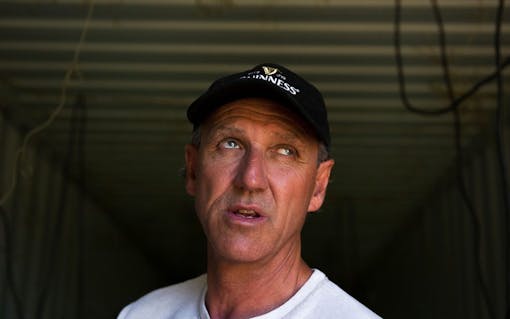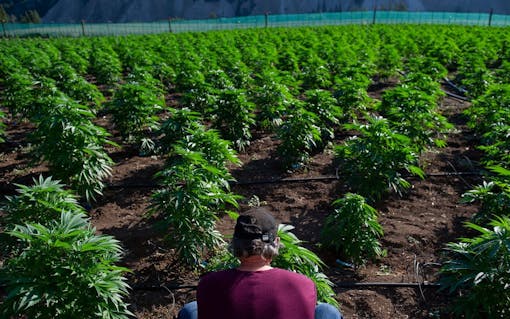Surrounded by snow-capped mountains, spindly Aspen forests and their own cattle herd, Rob and Linda Trotter of Pot Zero Farms in Western Colorado have discovered a spot that’s ideal for growing special cannabis in an eco-friendly way.
The Trotters have harnessed the magic of this environment—uncontaminated “snow-to-grow” mountain water, intense ultraviolet light, and biodynamic farming practices—to create some of the most CBG-rich cannabis plants in the business.
Snow melts off nearby 12,000 ft. mountains, trickles down collecting mineral nutrients and feeds Trotter’s 3,800 plants, which are never treated with chemicals or pesticides. Instead, they use a horde of 100,000 lady bugs to protect against aphid infestation, and a heard of Scottish highlander cows fertilize the soil.
What’s more, for the last 30 years Rob has lived with Retinitis Pigmentosa, a degenerative eye condition that causes his retina to deteriorate and has left him 85 percent blind.
Pre-Dawn Patrol
As a result, Rob’s farming methods are intense and peculiar. He wakes up every morning before the sun has a chance to crest the horizon.
'Eyes are an overwhelming sense. They block out other senses. Once you remove it, the other ones go way up.'
He navigates winding, rugged terrain in the dark, unlocks a secured gate, toggles some equipment, and walks through the plantation to feel and smell plants.
As his vision worsens, he says his cultivation acumen improves due to what he considers a “sixth sense”. Rob is capable of detecting slight changes in temperature on the back of his neck, allowing him to strategize his planting accordingly. He picks leaves by feel and smells buds to determine optimum time to harvest.
“Eyes are an overwhelming sense,” he says. “They block out other senses. Once you remove it, the other ones go way up. There’s a lot of benefit there.”
While driving his four-wheel buggy, he points out the hydroelectric pump, which he services and maintains based on how it sounds. This single turbine powers the entire facility and contributes to a zero-chemical, zero-waste operation. The Trotters pride themselves on marrying the green industry with green energy.
“It’s all about the plants, and all about this place, and me not screwing it up,” he said.
Fire and Snow Muck Up Your Plans
The environment isn’t always this forgiving, though. The Tritter’s grow cycle has been threatened by drought and the Lake Christine Fire, which burned more than 12,500 acres about seven miles away. And in October of 2017, eleven inches of snow dumped on the plants during harvest.
Shop highly rated dispensaries near you
Showing you dispensaries nearSurprisingly, the unexpected storm enhanced Pot Zero’s cannabis plants. After the snows, the Trotters discovered their plants were suddenly loaded with 15-30 percent THC and 1.5-4 percent CBG, the latter of which is one of the rarest and most therapeutic cannabinoids.
“Pretty much like the human race, with these plants what doesn’t kill you makes you stronger,” said Trotter. “They can be tortured by the weather, as long it does not kill them, and they are actually just stronger from it. They adapt, they cope, and they perform.”
Growing Every Day

For 30 years, Rob Trotter has lived with Retinitis Pigmentosa, a degenerative eye condition that causes his retina to deteriorate. He says he is 85 percent blind. As his vision worsens, his cultivation acumen improved due to what he considers a “sixth sense”. “Eyes, to tell you the truth are such an overwhelming sense, that they block out your other senses. Once you remove it, the other ones go way up. There’s a lot of benefit there,” he said. (Daniel Brenner for Leafly)

Rob Trotter check on his plants July 24, 2018 at TNT Ranch. The result is a pure product loaded with 15-30 percent THC and 1.5-4 percent CBG. Rob calls the unique compound “recreational therapeutic”, which allows for a more body-high with less anxiety. “They’re going to produce better camabinoid profiles under the sun and with minerals in the ground, and we’re proving that,” he said.(Daniel Brenner for Leafly)

A temporary worker carries trays of plants to put in the ground on June 19, 2018 at TNT Ranch. There are 3,800 plants between 10 to 12 strains. (Daniel Brenner for Leafly)

Rob Trotter opens a gate with his dog Chong while driving his buggy up the road to an upper lake to divert water May 16, 2018 at TNT Ranch. Snow melts off of nearby 12,500 foot mountains, trickles down collection minerals and nutrients, and feeds his plants. 2018 reported minimal snowpack and basins were about 60 percent of normal accumulations. (Daniel Brenner for Leafly)

Plants shortly after the germination phase May 26, 2018 at TNT Ranch in Gypsum, CO. Pip cleaners are used to hold up plants that are too weak. (Daniel Brenner for Leafly)

Rob Trotter turns off a light in a container June 19, 2018 at TNT Ranch. “Because of my eyesight, I do everything by feel. So if I pick fan leaves, I can feel them and know where they are located. I just come down the plant with my hands. Bang bang bang,” he said. (Daniel Brenner for Leafly)

Rob Trotter hops over a fence after corralling his cattle July 24, 2018 at TNT Ranch. The Trotters have 35 head of Scottish highlanders that are used to fertilize the soil. (Daniel Brenner for Leafly)

(Rob Trotter uses a watering can on his plants before planting in the soil June 19, 2018 at TNT Ranch. Snow melts off of nearby 12,500 foot mountains, trickles down collection minerals and nutrients, and feeds his plants. The Pot Zero concept combines a subalpine environment with an idiosyncratic process to result in a special product. There’s no use of chemicals or pesticide. Instead, they launch a horde of 100,000 lady bugs to eat aphids and mites. (Daniel Brenner for Leafly)

Francoios Nanin, a full-time, seasonal head gardener, uses a magnifying glass to check if a plant is ready to be harvested Sept. 29, 2018 at TNT Ranch. (Daniel Brenner for Leafly)

Francoios Nanin, a full-time seasonal head gardener, drinks some water June 1, 2018 at TNT Ranch. “As far as I can tell, unless something changes, it’s going to be a warm, warm year,” Rob Trotter said. (Daniel Brenner for Leafly)

Rob Trotter cleans a filter to the irrigation system June 19, 2018 at TNT Ranch. This is the first day plants were in the soil. The entire compound is also powered by a hydroelectric pump, which he services and maintains based on hearing. (Daniel Brenner for Leafly)

Francoios Nanin, a full-time seasonal head gardener, removes make-shift greenhouses that protect the plants and allow for sunlight June 1, 2018 at TNT Ranch. The plants have been moved outside containers and will be ready to be planted in the soil in a couple weeks. (Daniel Brenner for Leafly)

Rob Trotter uses a sprinkler hose to spray water on his property July 24, 2018 at TNT ranch. This grow cycle has been threatened by drought and the Lake Christine Fire, which burned more than 12,500 acres about seven miles away. “We will continue to monitor the fire and keep the compound wet,” he said. The Trotters has packed up valuable possessions in a car in case they were evacuated. (Daniel Brenner for Leafly)

Rob Trotter smells his plants shortly after the germination phase May 26, 2018 at TNT Ranch in Gypsum, CO. Trotter has been a farmer for 25 years, mostly cows and hay, but started growing marijuana in May 2015. He never asked others for tips or advise, and instead relied on trial and error. (Daniel Brenner for Leafly)

Rob Trotter and a temporary employee weigh a plant using a scale before harvesting Sept. 29, 2018 at TNT Ranch. (Daniel Brenner for Leafly)

Rob Trotter feels plants to see if they are ready for harvest Sept. 29, 2018 at TNT Ranch. “I can’t see the trichomes. I can tell a plant is done on two things, smell and hardness,” Trotter said. (Daniel Brenner for Leafly)

Francoios Nanin, a full-time seasonal head gardener, carefully measures non-GMO organic citric acid to properly pH the water supply June 19, 2018 at TNT Ranch. “We use nematodes in our water to protect against infestation of lava at roots. There’s things you do with mother nature that make the whole thing work without having to go into synthesized chemicals, and especially that’s really important with marijuana. Because they are sucker plants that pick up everything from the soil and put it into their buds,” Rob Trotter said. “The better, cleaner the soil is, the better the product is going to be.” (Daniel Brenner for Leafly)

Francoios Nanin, a full-time, seasonal head gardener, moves different strains of marijuana June 1, 2018 at TNT Ranch. The plants have been moved outside containers and will be ready to be planted in the soil in a couple weeks. (Daniel Brenner for Leafly)

Rob Trotter check on his plants July 24, 2018 at TNT Ranch. The Trotters have 3,800 plants between 10 to 12 strains. The Pot Zero concept combines a subalpine environment with an idiosyncratic process to result in a special product. There’s no use of chemicals or pesticide. Instead, they launch a horde of 100,000 lady bugs to eat aphids and mites. (Daniel Brenner for Leafly)

Rob Trotter walks back to his home after checking on his plants early in the morning on June 1, 2018 with his dog Scout, at TNT Ranch in Gypsum, CO. Trotter walks up a winding road in the dark to toggle lights and fans. He can feel changes in the catabolic air flow on the back of his neck. (Daniel Brenner for Leafly)

Rob Trotter checks on his plants early in the morning on June 1, 2018 with his dog Scout, at TNT Ranch in Gypsum, CO. Because of the high altitude grow operation at 8,200 feet, the farm can experience frost in the summer, and the plants are kept in a container until strong enough. (Daniel Brenner for Leafly)




